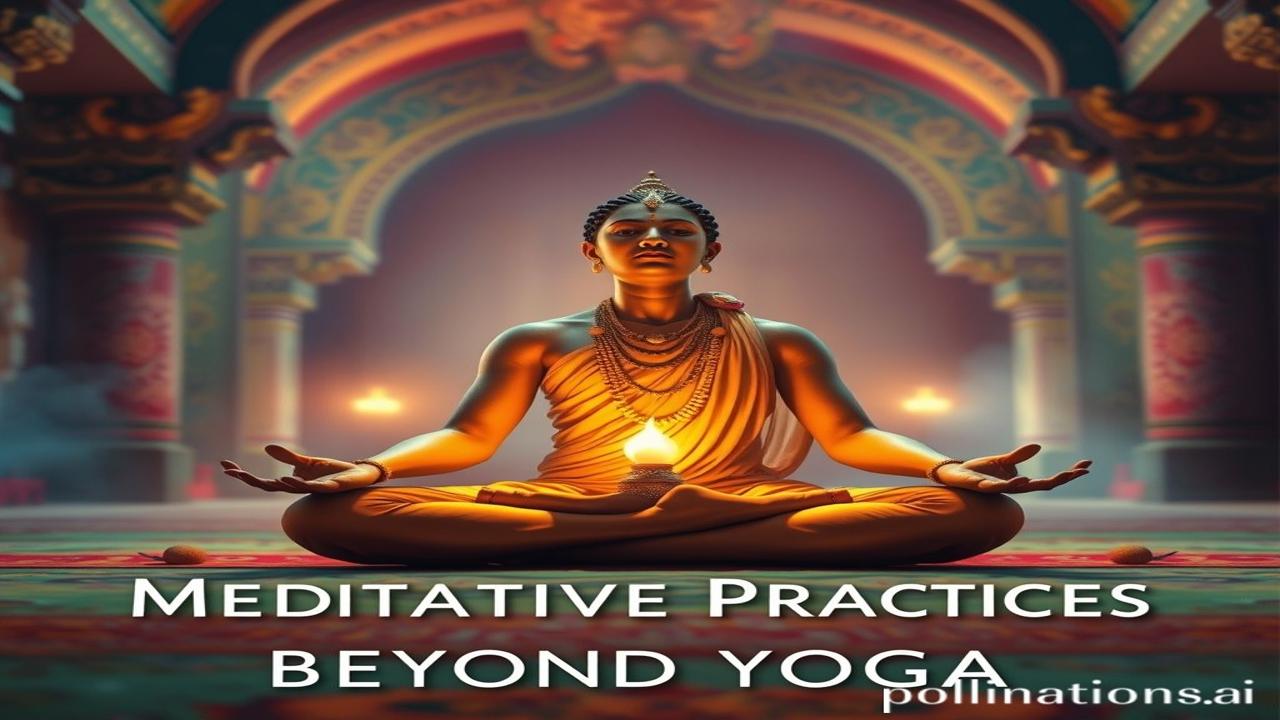Dhyan: Yoga Se Pare, Mann Ki Shanti Ka Raasta (Meditative Practices Beyond Yoga)
Kabhi socha hai, Ganga kinare kisi anjaan sadhu ki aankhon mein kitna gehra raaz chhupa hota hai? Waqt ki leharon mein dube hue, unke dhyan mein, unke antarman mein kitni shanti basi hoti hai. Hum sab yoga ko toh jaante hain, lekin yoga se pare bhi toh dhyan ke kai raaste hain, jo humare purvajon ne humein saunpe hain. Chaliye, aaj un raaston par ek safar karte hain.
Dhyan – Ek Itihasik Jhalak (Historical Glimpse)
Dhyan, ya meditation, Bharat ki Sanskriti mein hazaron saalon se chala aa raha hai. Yeh sirf ek exercise nahi hai, yeh jeevan jeene ka ek tareeka hai. Yoga, no doubt, ek important part hai, but dhyan is much broader. Iska zikr humare Vedas, Upanishads aur Buddhist texts mein bhi milta hai. Buddha ne khud dhyan ke zariye hi enlightenment prapt kiya tha. To be precise, dhyan is not just limited to a single religion or philosophy; it has been a core practice across various spiritual traditions in India.
Iska koi ek exact “date” nahin hai, kyuki ye dheere dheere evolve hua hai. But we can say that from around 1500 BCE, with the composition of the Vedas, dhyan started taking a more structured form. It’s important because it shows us how our ancestors valued inner peace and self-awareness, even amidst the chaos of life.
Prachin Bharat Mein Dhyan: Rajao Se Lekar Sadhakon Tak (Dhyan in Ancient India: From Kings to Ascetics)
Imagine a raja sitting silently in his chamber, not scheming for war, but meditating to understand his own mind. Or picture a wandering sadhu, clad in simple clothes, lost in deep meditation under a banyan tree. Dhyan was not limited to any particular class or caste; it was a practice available to all.
“Ma Rukmini ne aaj apne antarman mein jhakne ka nirdhar kiya,” whispers a dasi, “kyunki mandir ke utsav ke baad, unhe shanti ki talash hai.” The story might be imaginary, but the sentiment is real. Rulers used dhyan for clarity, artisans for inspiration, and common folk for solace.
Bhakti Marg: Prem Se Dhyan (Bhakti Marg: Meditation Through Love)
Bhakti marg, ya the path of devotion, is another powerful form of dhyan. Think of Meera bai, lost in her love for Krishna, singing bhajans and forgetting the world around her. Her devotion was her meditation. This path emphasizes love, surrender, and connection with the divine. It involves practices like chanting mantras, singing devotional songs (bhajans), and engaging in acts of selfless service (seva).
Aaj Ki Bharatiyata Mein Dhyan (Dhyan in Today’s Indian Identity)
Aaj bhi, Bharat mein dhyan zinda hai. You see it in the simple aarti that your grandmother does every morning, in the silent prayers offered in temples, and in the increasing popularity of meditation apps. Dhyan is woven into the fabric of our “Bharatiyata,” reminding us to take a moment to breathe, to connect with ourselves, and to find peace within the chaos.
It’s visible in the serene faces of people practicing Vipassana, in the rhythmic chants of Buddhist monks, and in the quiet reflection of individuals seeking inner peace in a bustling city park. Dhyan is not just a historical practice; it’s a living tradition that continues to shape our identity.
Kuch Rochak Tathya (Some Interesting Facts)
- Myth Buster: Log samajhte hain ki dhyan sirf yogi aur sanyasi karte hain. Lekin asli sach yeh hai ki dhyan koi bhi kar sakta hai, kabhi bhi kar sakta hai. You don’t need to sit in a specific posture or live in a cave. Just five minutes of mindful breathing can make a difference.
- Did you know that certain forms of Indian classical music are designed to induce a meditative state? The ragas, the rhythm, and the melody all work together to calm the mind and open the heart.
Drishya Aur Bhavnayen (Visuals and Emotions)
Imagine the smell of incense wafting through a dimly lit temple. The cool, smooth feel of marble under your bare feet. The echoing chants of mantras resonating in the air. The gentle sound of flowing water from a nearby river. Dhyan is not just a mental exercise; it’s a sensory experience. It’s a holistic experience, engaging all your senses to create a state of inner peace and heightened awareness.
Antim Vichar (Final Thoughts)
Dhyan sirf yoga se pare nahi, yeh hum sab ke andar bhi hai. It’s a treasure waiting to be discovered. So, take a deep breath, close your eyes, and listen to the silence within.
- “Shanti patha sabse mushkil hai, par usse sundar koi aur nahi.” (The path to peace is the most difficult, but none is more beautiful.)
